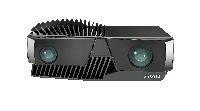 |
Zivid C++ API
2.4.2+1a2e8cfb-1
Defining the Future of 3D Machine Vision
|
 |
Zivid C++ API
2.4.2+1a2e8cfb-1
Defining the Future of 3D Machine Vision
|
Container for input-data needed by in-field verification and correction functions. More...
#include <Zivid/Experimental/Calibration/InfieldCorrection.h>
Public Member Functions | |
| ZIVID_CORE_EXPORT | InfieldCorrectionInput (const Zivid::Calibration::DetectionResult &detectionResult) |
| Constructs an InfieldCorrectionInput instance. More... | |
| ZIVID_CORE_EXPORT const Zivid::Calibration::DetectionResult & | detectionResult () const |
| Get the stored feature-point detection result More... | |
| ZIVID_CORE_EXPORT InfieldCorrectionDetectionStatus | status () const |
| Get detection status/validity as an enum More... | |
| ZIVID_CORE_EXPORT bool | valid () const |
| Check if the data is valid for use with in-field verification and correction More... | |
| ZIVID_CORE_EXPORT | operator bool () const |
| Check if the data is valid for use with in-field verification and correction More... | |
| ZIVID_CORE_EXPORT std::string | statusDescription () const |
| Get human-readable description of the status. Useful for feedback if valid() is false. More... | |
| ZIVID_CORE_EXPORT std::string | toString () const |
| Get string representation of the in-field correction input More... | |
Container for input-data needed by in-field verification and correction functions.
The constructor takes a Zivid::Calibration::DetectionResult. Such an object may or may not contain data of sufficient type and quality for in-field verification and correction. This will be reflected by the result of the status() or valid() functions, and if invalid a human-readable reason will be accessible with the statusDescription() function.
| ZIVID_CORE_EXPORT Zivid::Experimental::Calibration::InfieldCorrectionInput::InfieldCorrectionInput | ( | const Zivid::Calibration::DetectionResult & | detectionResult | ) |
Constructs an InfieldCorrectionInput instance.
Input data should be captured by calling detectFeaturePoints with a Zivid::Camera argument.
| detectionResult | A feature-point detection result |
| ZIVID_CORE_EXPORT const Zivid::Calibration::DetectionResult& Zivid::Experimental::Calibration::InfieldCorrectionInput::detectionResult | ( | ) | const |
Get the stored feature-point detection result
|
explicit |
Check if the data is valid for use with in-field verification and correction
This operator is merely a shorthand for the valid() function.
| ZIVID_CORE_EXPORT InfieldCorrectionDetectionStatus Zivid::Experimental::Calibration::InfieldCorrectionInput::status | ( | ) | const |
Get detection status/validity as an enum
| ZIVID_CORE_EXPORT std::string Zivid::Experimental::Calibration::InfieldCorrectionInput::statusDescription | ( | ) | const |
Get human-readable description of the status. Useful for feedback if valid() is false.
This returns a free-form string and should not be considered API stable.
| ZIVID_CORE_EXPORT std::string Zivid::Experimental::Calibration::InfieldCorrectionInput::toString | ( | ) | const |
Get string representation of the in-field correction input
| ZIVID_CORE_EXPORT bool Zivid::Experimental::Calibration::InfieldCorrectionInput::valid | ( | ) | const |
Check if the data is valid for use with in-field verification and correction